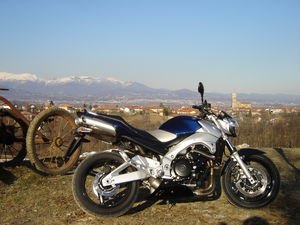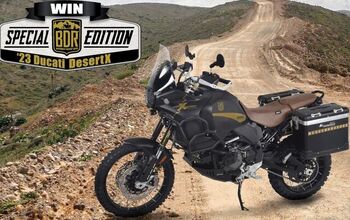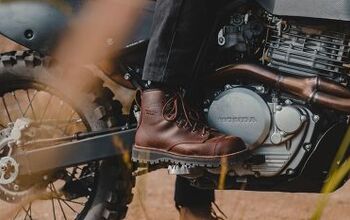2006 Suzuki GSR 600 - Motorcycle.com
It was only after ten days of riding the new Suzuki GSR600 that I noticed a strange coincidence. Turns out that this new Naked 600 closes a decade long cycle for me. Yep, it was back in 96' when I was given for the first time a new road bike to road test for a magazine and it was none other than Suzuki's own Bandit 600.
I can remember all too well my doubts after I was done with the riding. Is this bike so good, so well rounded, so RIGHT or is it only my enthusiasm from my maiden road test that's distorting my judgement? I still remember myself going all weak in the knees in front of my old PC's empty screen but at the end of the day I went with my gut feelings and wrote earth-moving phrases like, "fun in the twisties AND the city" or "a perfect road oriented do-it all tool" and other assorted gems..... Boy, was I original....
Was my enthusiasm misplaced? After all, even back in 96', the Naked-all-rounder concept wasn't exactly new. Leaving 70's and 80's UJM's aside, 93' saw the introduction of Ducati's Monster while Honda's 750 Nighthawk was already well received in the US a decade earlier. In the Japanese market, small 250-400 cc nakeds where anticipating the models that were to conquer Europe later on.
Looking back in time, it'll be hard to deny that the 600cc Bandit was the bike that really kick started the Naked thing in earnest. Within the emerging specialized categories of Supersports, Touring, Big Trailie and others, the Bandit offered an affordable 360 degree tool, something to scratch your pegs with on the weekends, ride to work in between or take a medium-range tour on. The Bandit possessed a sporty engine in a good handling frame and no less important, had an appealing and aggressive design (an area where the Nighthawk was a bit lacking). Turns out I wasn't the only one to get excited about Suzook's Bandido. It shot right up to the top of the European sales hit parades and even in the dichotomic Sport vs. Cruiser American market, it enjoyed quite a success for a while.
But life goes on and a radical remake of the Bandit 600 was in the cards. In the last seven years Bandit copycats such as the Hornet 600 / 599 and Yamaha's Fazer 600 have dominated European markets by offering major improvements of Suzuki's concept.
Here is where our decade-long cycles meet. Ten years have passed, and after finishing my test of the new Suzuki GSR600 I felt like I could have copied and pasted entire paragraphs from that maiden road test. These medium-weight nakeds, call them standards if you wish, still feel so right, so well rounded, and so useful. More to the point, Suzuki's own reinterpretation of the concept is really that good.
Suzuki left the Bandit 600 pretty much alone all those years. 2000 saw a medium frame/design review while last year displacement was bumped by 50 cc, but that was all that happened in a decade-long production run. A major redesign was required then and, indeed, the bike gets the new initials "GSR"; the old Bandit was sold under the GSXF moniker (and will remain in production). Back in 96' Suzuki could make do with the already-old GSXR air-oil cooled mill but now, with the Honda/Yamaha Nakeds using 600 supersport-based engines, last years GSXR600 power unit has called to service.
'...the GSR600 sports a very impressive and stiff-looking alloy swingarm while its two main competitors have a rather boring looking steel schwinger'
Although the best-selling Honda 599 uses a rather simple steel backbone frame, Suzuki preferred to get aligned with Yamaha's Fazer 600 and use an aluminum twin-spar job. This might look initially a bit over the top for a do-it-all thingie but like in the SV650 and said Fazer, this twin spar frame is an all-cast affair with the two halves of the frame, left and right, simply bolted together. Without any proper welded hollow sections (it's an easy-to-cast "C" section all around), production costs can be extremely low while the visual impact is quite strong. I can't say I really like the idea of such hefty-looking spars in a naked model; in my humble opinion they simply hide the engine from view, a real no-no in a naked, but again, that's a matter of taste.
Could the GSR be the Naked 600 that makes American beginners see the light? Suzuki had quite some time to study the competition and try to come up with a slightly better spec for their tool. Not an easy task in this economy-oriented category, yet the GSR600 sports a very impressive and stiff-looking alloy swingarm while its two main competitors have a rather boring looking steel schwinger. It's a cast unit with a serious bracing bridge and it wouldn't look out of place on a true supersport mount.
Back to the engine. There was no way that the old air/oil cooled unit could be brought to the required levels of performance. The 2004 GSXR600 mill on the other hand is truly up to date with narrow included angle between its valves, stacked transmission shafts for compactness, and servo-controlled secondary butterflies in the throttle bodies. The tuning changes made for use in a relaxed naked model have been a slight reduction in valves and throttle body size, using steel rather than titanium for the valves and milder camshafts. Claimed figures are 98 hp at 12,000 rpm and 47.7 foot-pounds of torque at 9,600 rpm.
The figures are quite competitive but I already anticipate that this motor has a surprise in store. As noted before, the middleweight naked class is an extremely competitive, one where each little extra feature counts and I have to admit that Suzuki, true to their value for the money tradition tried to go the extra mile. The front calipers seem to be ex- GSXR stuff, the fork has pre-load adjustment and the rear shock has both preload and return damping adjustment. Not ground-breaking stuff but these are features missing in the 599 or Z750 nevertheless.
The GSR 600's design deserves a whole paragraph of discussion, if only to point out what could have been. Putting the Hans Muth-designed 80's Katanas aside, most will agree that Suzuki designers don't often take our collective breaths away with their wares. Yet in 2001, a certain prototype named B-King was shown in the Tokyo show and it left grown men weeping.
The supercharged 1300 cc Hayabusa powered thing was as aggressive as a Hezbollah terrorist on the loose. "We want one!" was the common reaction in many a gentlemen club and in this year's Paris show, most everybody was expecting a production version of the beast. But what we got instead was this GSR600 mini-B-King look-a-like. Never mind the missing cc's, design wise the GSR600 look like a very watered down version of the original B-King concept. You can see that Suzuki's designers tried real hard with the GSR but the end result lost most of the energy and aggression, ending up with a design that lacks in clarity, too middle of the road. The tail section with the twin headlight and twin silencers creating an MV-F4-like look is a touch of genius but the sheer fatness at fuel tank is plain strange and exaggerated by those built in turn indicators sunk into the silver plastic frame covers.
As said, nice touches abound, like the sculpting of the seat that's upholstered with two fabric types and the Ducati-like position for the ignition switch. The GSR 600 doesn't look bad, it just lacks coherence and knowing how good the b-King looked, it's a bit of a let down visually speaking. The chosen publicity slogan for the GSR is "Modern art meets race technology". I'd say that someone got carried away somewhat.
Like what you see? Or maybe you don't? Well, riding the GSR 600 made me forget all criticism quickly. Just like that good old Bandit, the GSR feels super right from the moment the wheels start to roll. "User friendliness" are the first words that come to mind; it begins with an extra-sweet throttle response from absurdly low revs for an inline 600 four. Part of the trick seems to be the lowering of ratios in the first four gears but regardless of gearing, the servo-operated secondary butterflies provide a truly magic response. Let the clutch fully out at 4000 revs, and the engine picks up really nicely.
The riding position is just as comforting; erect, very in control of the situation, but a tad tight for my 6'4". Let the thing roll and within one yard you feel like putting your feet on the pegs while the steering feels simply neutral; light but with enough feedback and feel. It's the kind of warm welcoming that could make any newcomer feel so much at home from the word go. Being used to riding in town on my big GSXR, after 10 minutes of city riding on the GSR 600, I am in a scooter-like nirvana. Gliding along a boulevard I roll on the throttle in an impossibly high gear and the GSR just drives on from 3000 revs.... Say what?! Isn't this a whiny 600?
This is one area where Suzuki's GSR seems to have a fat card up its sleeve. Looking up some dyno measurements already published around here, the torque curve seems to be about same as in the 599 or Fazer, yet in real life I can testify that the last two need at least a good 5-6,000 rpm to pull cleanly. It's the classic where a dyno run dun on a Dynojet type inertia roller bed (always on full throttle) doesn't tell the whole story. What really counts often is partial throttle response and in that sense the GSR excels. It is very elastic. In city riding conditions you are helped also by a high lock to lock steering angle, smooth controls and large field of view courtesy of the compact and enduro-like seat-footpegs-bar triangle. The only negative comment till now is the slightly notchy gearbox that requires an extra effort when trying to find neutral at light stops, a very un-typical problem for a Suzook.
'Just like I felt at lower speeds, the GSR's steering has got a nice mix of easiness and quickness...'
OK, by now its clear that this GSR has a genetic proximity to city-dwelling scooters but what interests me more is how thing things handles corner carving. In tight, medium-slow curves of the mountain roads around Milan, my tool of choice is something with flat bars rather than clip-ons and this GSR looks like a prefect mate for some winter time lunacy. My lunacy will be enabled by the sticky 014 Bridgestones, stoppie-inducing GSXR brake calipers, the point and shoot seating position and above all my carving hunger after the long winter. It's high thirties-low forties outside but I need some adrenaline. Badly.
Brrrr....Brrrrr..... Cruising along on the highway I soon discover what I knew all along, Naked bikes are naked indeed and this one is more naked than most. The instrument pod is way down there, so wind protection is less than non existant while the closeness of seat to bars doesn't allow me to tuck in at all. Having grown up on standards I usually don't mind hammering on at 90 without a fairing but the temperatures and the short gearing mean that on the GSR I prefer to roll along at 75-80.
I arrive half frozen at Biella, defrost somewhat at my girlfriend's house and then I am ready to roll again. I've long longed to check out the twisties that lay between Biella and Ivrea, a "Mount Palomar" kind of spot for the locals. As I climb higher, temperatures drop right to freezing though it means I have the road all to myself, with almost no squids around.
Words of praise must go to the dear souls at Bridgestone Tires, Inc. These guys know a thing or two about making tires work in the cold (Japan being quite a cold country) and the first thing to shock me is the available grip with frozen tires. Seeing that I can count on reasonable grip, I start to push the GSR some and as with other middle weight nakeds, I feast on that easy-to-throw-around feeling. Just like I felt at lower speeds, the GSR's steering has got a nice mix of easiness and quickness when tipping the thing in while when cranked over; there's proper weight on the front end and reassuring feedback. With frozen roads and frozen tires, I need all the feedback that I can get. As I climb, the roads are more and more covered with salt and grime and grip level changes from turn to turn. Yet this GSR's frame and the medium-stiff calibrated suspension are really sorted while the zero load on wrists lets me sense feedback from the bars really well.
The conditions bring to light also the exceptional response to the throttle I noticed earlier when I do have to chop the throttle due to serious salt spots and pebbles on the road. Cracking it open results in useful drive and not a puny "boooaaaa" from an off the powerband engine. It's no arm wrenching pull from 4,000 rpm, more the feeling of not having to drop down two gears every other turn to get proper drive. The result is more flowing riding while the ability to precisely modulate the engine's power helps greatly when the rear does spin a bit over the really loose stuff.
By now my ass cheeks are truly frozen yet it looks like I've managed to "clean" the whole width of the tire's tread. Is it winter nirvana? Well, not exactly. With all due respect to the precise fueling, in throttle- off/ throttle-on situations there's a delay in response and the higher the gear, the bigger the impact that is felt through the tranny. If you are experienced enough you can avoid the jolt by not closing the throttle fully and dragging the rear brake while cornering. Doing so, the power flows again smoothly when cracking the throttle back on but it's not the easiest exercise for a novice.
Having the GSR for a full week means you are able to stretch its legs when long enough straights come along. At 8,000-9,000 rpm there's a nice hike in power and eventually the GSR will climb into five-figure revs but there's little point in reaching the red-line at around 12K and change; no real kick is waiting for you up there. For more expert riders that might be a bit of a disappointment and some comparative measurements show that seat of the pants feel was right. GSR pumps out about 83-84 rear wheel hp, exactly as the seven year-old Honda 599, and a good six or seven hp less than Yamaha's Fazer.
Is it a problem? Well, yes and no. Naked 600's aren't meant to be land speed record holders anyway and for the typical buyer, i.e. a beginner to mid-level rider, it won't be such an important issue. On the other hand, I felt like the frame could handle quite a lot more power. Some people might outgrow the GSR600's too soon and I expected the new kid on the block to be stronger, specially considering the sporty origins of the engine.
At the end of the day the GSR delivers some concrete improvements over its rivals. Kudos to the Suzuki boys for engineering some real mid-range drive in a middleweight, giving us excellent brakes and chassis manners and keeping that neat, feel-good all-aroundness that is so hard to pinpoint. The GSR 600 is going to deliver all that at a price that is a few hundred Euros bellow that of the competition. If it only had a more clear statement design-wise, like the pure aggressiveness of the Z750 or the refined sculpting of the Fazer; it would be a real hit. But even as is it's a sure bet that the GSR will fight it out with the established players in the 600 Naked class.
If anything, the real shame is that the chances to see this groovy 600 in the US are pretty slim. Judging by the "success" of Naked standards such as the 599, 919 and Fazer in America, there seems to be no love for these fairingless things across the pond. On the other hand, could the GSR be the Naked 600 that makes American beginners see the light?
| 2006 Suzuki GSR600 Specs | |
| Overall Length | 2,090 mm (82.3 in.) |
| Overall Width | 775 mm (30.5 in.) |
| Overall Height | 1,075 mm (42.3 in.) |
| Wheelbase | 1,440 mm (55.1 in.) |
| Ground Clearance | 130 mm (5.1 in.) |
| Seat Height | 785 mm (30.9 in.) |
| Dry Mass (claimed) | 183 kg |
| Fuel Capacity | 16.5 litres |
| Engine Type | 4-stroke, in-line 4-cylinder, liquid-cooled, DOHC |
| Bore x Stroke | 67.0mm x 42.5mm |
| Piston Displacement | 599.4cc |
| Compression Ratio | 12.5:1 |
| Carburettor | Fuel injection 38 mm |
| Lubrication | Wet sump |
| Ignition Type | Electric |
| Transmission | 6-speed constant mesh |
| Drive System | Chain |
| Front Suspension | 43mm telescopic forks fully adjustable srping preload |
| Rear suspension | Link-type, coil spring, oil-damped, spring preload 7-way adjustable, rebound damping force fully adjustable |
| Rake/Trail | 25.5 degrees/105.0 mm (4.1 in.) |
| Front brake | 4-piston calipers, 310 mm dual-discs |
| Rear brake | 1-piston caliper, 240 mm disc |
| Front tyre | 120/70ZR-17M/C (58W), tubeless |
| Rear tyre | 180/55ZR-17M/C (73W), tubeless |
More by Yossef Schvetz



































Comments
Join the conversation